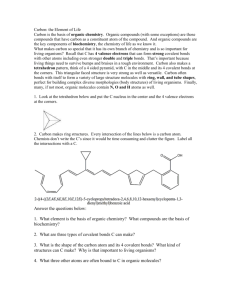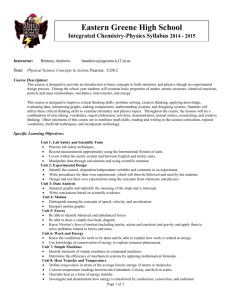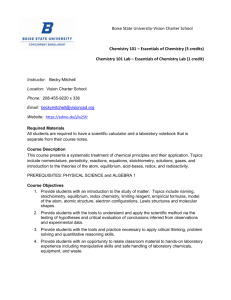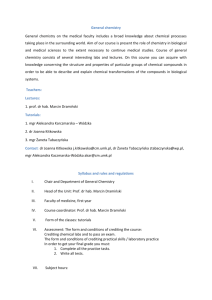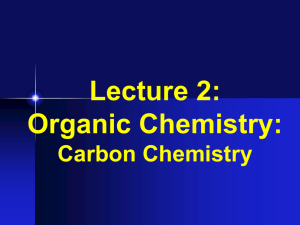CH131 - Mohawk Valley Community College
advertisement
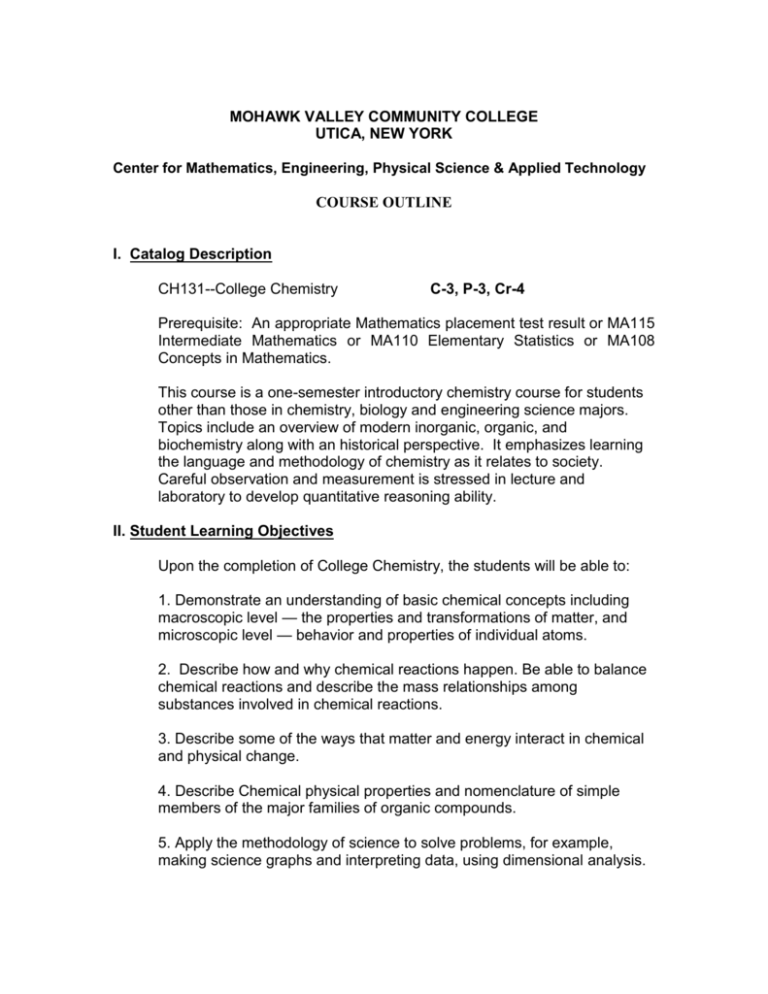
MOHAWK VALLEY COMMUNITY COLLEGE UTICA, NEW YORK Center for Mathematics, Engineering, Physical Science & Applied Technology COURSE OUTLINE I. Catalog Description CH131--College Chemistry C-3, P-3, Cr-4 Prerequisite: An appropriate Mathematics placement test result or MA115 Intermediate Mathematics or MA110 Elementary Statistics or MA108 Concepts in Mathematics. This course is a one-semester introductory chemistry course for students other than those in chemistry, biology and engineering science majors. Topics include an overview of modern inorganic, organic, and biochemistry along with an historical perspective. It emphasizes learning the language and methodology of chemistry as it relates to society. Careful observation and measurement is stressed in lecture and laboratory to develop quantitative reasoning ability. II. Student Learning Objectives Upon the completion of College Chemistry, the students will be able to: 1. Demonstrate an understanding of basic chemical concepts including macroscopic level — the properties and transformations of matter, and microscopic level — behavior and properties of individual atoms. 2. Describe how and why chemical reactions happen. Be able to balance chemical reactions and describe the mass relationships among substances involved in chemical reactions. 3. Describe some of the ways that matter and energy interact in chemical and physical change. 4. Describe Chemical physical properties and nomenclature of simple members of the major families of organic compounds. 5. Apply the methodology of science to solve problems, for example, making science graphs and interpreting data, using dimensional analysis. 6. Record data accurately obtained from physical and chemical measurements and observations, understand the difference between accuracy and precision. 7. Do simple data manipulations/calculations and report them correctly. 8. Demonstrate quantitative reasoning. 9. Differentiate between what professional laboratory personnel can and cannot do with data or samples presented to them. 10. Demonstrate critical thinking about scientific content and science processes in response to the wider concerns of a highly technological society and a complex scientific landscape. 11. Demonstrate an understanding of the importance of safety in the laboratory, the safe handling and disposal of chemicals in the laboratory, the home, and in the environment. III. Major Topics Topics will be chosen from but not limited to the following areas: 1. Matter — properties; three states of matter; distinguish between mixtures and pure substances; and between elements and compounds; distinguish between chemical and physical properties; Names and Symbols of the Elements. 2. Measurement in Chemistry — name and use the metric and SI units of measure for mass, length, volume and temperature; significant figures; dimensional analysis to convert quantities from one unit to another; definitions of energy, heat, specific heat, density. 3. Atomic Structure and the Periodic Table — Major assumptions of atomic theory; composition of atoms; isotopes and atomic weight; arrangement of periodic table and its relationship with the electron structures of atoms; arrangement of electrons in atoms. 4. Chemical Bonding — definitions of ions, ionic bonds and covalent bonds; properties of ionic compounds and covalent compounds; Octet rules and its usage to predict formation of ions or covalent bonds; chemical formulas of ionic compounds; molecular formulas and Lewis structures of covalent compounds; electronegativity and bond/molecular polarity; nomenclature; major differences between ionic and covalent compounds. 5. Chemical Calculations — mole concept; relationship between molar quantities and mass quantities; write and balance chemical equations; chemical calculations involving chemical equations. 6. Gases, Liquids and Solids — Kinetic-molecular theory of gases; gas laws; concepts of heat change, equilibrium and vapor pressure to changes of states; major intermolecular forces. 7. Solutions — characteristics of solutions; influence on solubility of solvent and solute structure, temperature, and pressure; concentration of a solution; dilution; colligative properties of solutions; osmosis. 8. Chemical Reactions — chemical reaction types; oxidation numbers and redox-nonredox reactions; collision theory in chemical reactions; energy change during reactions; activation energy and factors that determine reaction rate; chemical equilibrium and Le Châtelier's principle. 9. Acids, Bases, and Salts — Acid-base theories; strengths of acids and bases; ion-product constant for water; pH concept; the formation of salts; definition of buffer; how a titration procedure works and the usage of the results to calculate acid or base concentration in a solution; strong and weak electrolytes and Nonelectrolytes. 10. Nuclear Chemistry — basic concepts about radioactivity; three common kinds of radiation—, , and rates of nuclear reactions; write and balance equations for nuclear reactions; the danger and benefit of radiation; nuclear fission and nuclear fusion. 11. Organic Chemistry — classify organic molecules into families by functional group; structural formulas and condensed or line structures; recognize and draw isomers; categories of organic reactions; structures and nomenclatures of major organic families; general properties and chemical reactions of major organic families; 12. Carbohydrates — occurrence and functions of carbohydrates; classification of carbohydrates; chirality; photosynthesis. COLLEGE CHEMISTRY LABORATORY SCHEDULE WEEK 1 2 EXP# 3 4 1 2 3 5 6 7 8 9 10 11 12 13 14 15 4 5 6 7 8 9 10 11 12 13 Make up TITLE -No lab -Check in -Fundamental Laboratory Operations -Safety in the Laboratory -Video: 28 Grams of Prevention -Laboratory Techniques -Measurement -Extraction of Food Dyes and Paper Chromatography -Properties of Oxygen -Periodic Table -Mole Relationship in a Chemical Reaction -Synthesis and Purification of Aspirin -Properties of Gases -Water and Solutions -Chemical Reactions and Equilibrium -Acids and Bases -Hydrocarbons -Alcohols, Esters, Aldehydes and Ketones -Determine Ideal Gas Constant R The laboratory exercises will be performed utilizing the laboratory manuals edited by Dr. Pan. The laboratory exercises are designed to augment the theory which has previously been developed in the classroom. The data and calculations will be recorded in the laboratory text. These pages are turned in as part of the final lab grade. By F. Pan 2015 Fall
